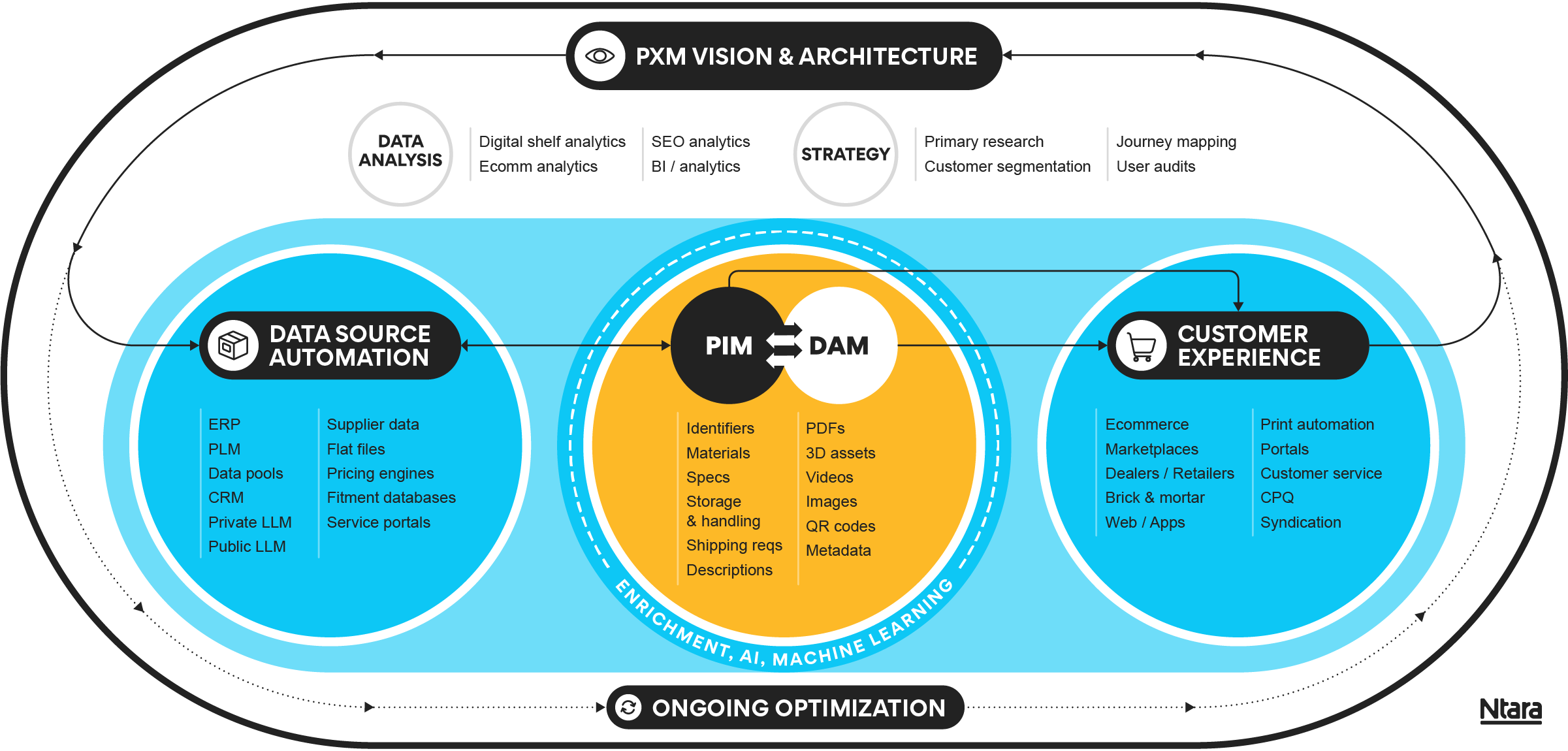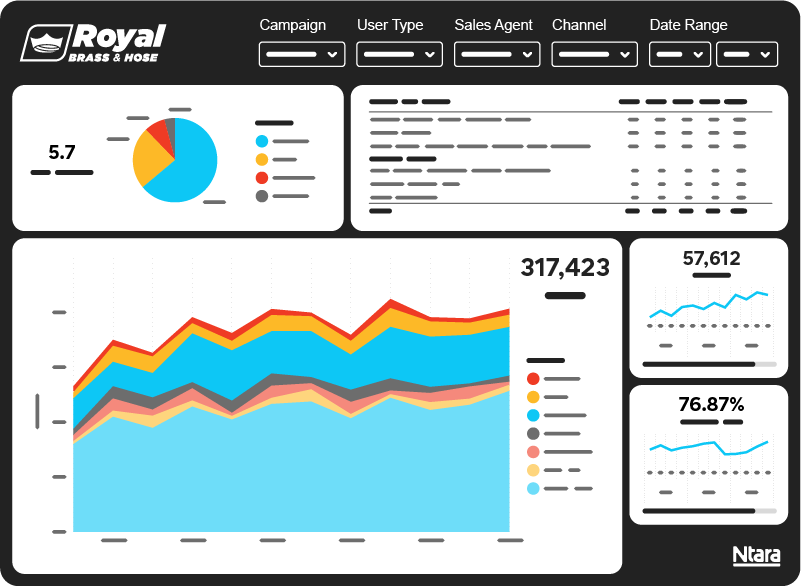Product experience management (PXM) is an emerging term that causes some confusion. Is it a technology? A process? A trendy saying that belongs on your next corporate swag t-shirt for your product teams? Something else?
Business jargon comes and goes, but we see PXM as an important combination of people, processes, and technologies that work together to manage product data for consistent customer experiences.
Our unique perspective on this comes from implementing PXM for global industrial and consumer brands long before it was an acronym. Our experience shows that PXM goes beyond accurate product data or a point solution.

Before we go any further, let’s break the PXM term down:
Product: The finished good a manufacturer, supplier, or retailer sells. Modern companies are expanding the definition of a sellable product, recognizing that “productizing” their offerings is the key to selling successfully across channels. In addition to the consumer or industrial products we are all familiar with, other industries are getting in on the product-first approach, such as:
- Hospitality: hotel properties and individual rooms
- Content creators: downloads or streaming media
- Technology: services packages and maintenance agreements
- Healthcare: elective procedures and routine services
eXperience: The sum of the product’s presentation and the actions taken by a buyer across all potential buying (or service) channels. This includes both digital and “in real life” channels like:
- Digital commerce: ecommerce (B2B and DTC), punchout, customer portals
- Brick-and-mortar stores and service counters
- Supplier/distributor websites
- Sales and service collateral
To add a bonus level of complexity, this also includes channels that are not under the direct control of the company, such as review websites, social influencers, secondary markets, etc.
Management: The internal practice of purposefully measuring and progressively improving the product experience of buyers. This includes the people, processes, and technologies involved in managing product data and assets. We know that the foundation of every great buying experience is trust. When a buyer trusts their product experience, they can confidently say:
- I can find the information I seek (availability)
- The information is correct across all touchpoints (accuracy)
- My experience is seamless in my preferred channels (consistency)
- I know I am buying the right product for my use case (application)
B2C buyers use between 3-5 channels, and the average B2B buyer requires over 27 touchpoints before making a purchase. That means that managing product data and the product experience across channels is more critical than ever.
PX drives CX
Forrester Research confirms what we see in the marketplace every day: “The product experience [PX] you offer has the most impact on a brand’s overall CX [customer experience].”
Loyalty is hard won in our fragmented marketplace for both B2C and B2B. If the customer can go anywhere, why would they return to you? Experience is everything, outranking price and the product itself.
That’s why the common thread of PXM is not the product—it’s customer-centricity. Understanding this nuance helps you confidently take the following steps in assembling people, processes, and technology for PXM.

Connecting systems for PXM
According to a Forrester report on PXM, best-in-class product experience does not come from product data alone. Instead, PXM puts everything customers need at their fingertips — descriptions, pricing, specs, reviews, digital assets, content (such as manuals), localized information, recommendations, and even brand values.
The tech components that support this experience include PIM + DAM—with special attention to product data syndication to get your data to the right channels, and digital shelf analytics so you can see what’s working and keep the feedback loop rolling.
This is where B2B organizations often end their focus. However, from our perspective, PXM should also extend to ecommerce. Whether you call it ecommerce or a buyer portal, your business needs a closed-loop online product experience that is fully managed by your brand.
Buyers may not always expect a buy button. But they do want web-based experiences for product research, order status, service, support, and product recommendations. This experience often requires configure-price-quote capability to personalize offers and pricing.
Research shows that when a manufacturer or distributor launches ecommerce, they experience a significant lift, regardless of channels. That’s because ecommerce forces you to organize your data, think through your product story, identify every required input/output, and understand how your systems should interconnect. In other words, everything that’s required for successful PXM.
The five key concepts of PXM
The road to proper PXM is challenging, and every business is unique. As the number of channels required for buying accelerates, companies feel further and further behind. Our recent study showed that less than 3% of companies surveyed felt like they were “very much ahead of the competition.”
Successful PXM deployments have the following components:
- PXM vision and architecture
- Data source automation
- PIM + DAM
- Channel syndication
- Ongoing optimization
The systems are developed and maintained using a MACH approach, meaning that as business conditions (and buyer behavior) change, the system is nimble enough to be quickly adapted. This diagram shows what a modern PXM-enabled business looks like.

PXM vision and architecture
Don’t skip this step. Our research indicates that companies that begin their PXM projects with advanced, customer-centric initiatives in mind to improve their buyers’ experiences can expect to see up to a 39% lift in their financial outlook for the year.
Setting a vision for a PXM project involves many steps, but it starts with understanding your buyers on a deeper level and having a data-backed point of view on what aspects of their experience matter most to them. Conducting qualitative and quantitative research is one of the most successful ways to be certain of your PXM investment decisions.
Additionally, putting the correct forward-looking analytics systems in place, such as digital shelf analytics, is critical to understanding the impact your PXM projects are having over time. These systems can also alert you if your channels are making changes to how products are displayed, and how your customers’ experiences are changing as a result.
Data source automation
The lifeblood of a product-led company is product data. And we know this data is often sourced from dozens of places in an organization. A PXM practice will consider the starting point, enrichment point, and archival points of all product data and product assets.
Automation occurs when data is automatically harvested from the relevant systems (such as ERPs, PLMs, data pools, etc.) and pushed into PIM and DAM systems.
For manufacturers, this is often more straightforward, and they control most of their informational supply chain. For suppliers and distributors, it’s more complicated and often requires additional work to standardize information flowing in from hundreds or even thousands of potential data sources.
PIM + DAM
These two powerful technology systems are the engine that powers PXM for modern brands. Simply put, PIM is the central source of truth for product data, while DAM is the same for product assets. In recent years, these systems have moved from being seen as back-office IT projects to rocketing forward as the cornerstones that enable consistent, cross-channel buying experiences.
Channel syndication
Syndication is another term that has evolved over time in the world of PXM. For modern PXM, syndication refers to the act of distributing product data and assets to the appropriate buyer channels, in the right format, and at the right time.
Think of this as the management of the actual locations in which your buyers are spending their time experiencing your products, such as ecommerce, marketplaces, brand sites, customer portals, etc. These channels are increasing in number and complexity, but the good news is that leading PIM + DAM systems are purpose-built to handle it.
Ongoing optimization
Managing change is the constant in maintaining a PXM. Changes in a company’s product offerings, M&A activities, channel partners, back-office systems, and customer behaviors can all be successfully navigated with a thriving and active PXM framework in place.
Internal metrics, such as analytics from PIM and DAM usage, etc., should be regularly reviewed alongside changes to buyer behavior to optimize the system. You can find these metrics through external analytics data and ongoing customer segmentation surveys. Otherwise, your PXM practice will remain siloed and unmanaged. This is a sure way to waste huge sums of time and money in the future.
Learn more about PXM trends in our recent digital commerce benchmarking study.
PXM behind the scenes
We know that PXM is centered around the customer. But internally, it’s also about the user.
In the Forrester study on PXM, respondents revealed that their organizations do not struggle with a lack of PXM technologies. Rather, they have trouble tapping into key functionalities needed for PXM.
This shows that having best-of-breed systems isn’t enough. They must be configured correctly, empowering your employees to easily enrich product information and dedicate more time to higher-value tasks.
Data analytics is another internal gap that needs to be addressed. Dashboards are especially important for the closed feedback loop that validates your PX decisions and helps you target areas for improvement.

Royal Brass & Hose, for example, worked with Ntara to integrate ecommerce and sales performance data with relevant product information to create a custom analytics dashboard with Power BI. This ultimately drove 20% YoY growth in online revenue. Taking a big-picture approach, they continue to hit major milestones on their PXM journey.
Recap: Steps to PXM
1: Start with a clear understanding of your customers’ expectations. Conduct customer segmentation research to make decisions based on data instead of trends or assumptions.
2: Adopt a big-picture strategy for PXM, bringing together decision-makers across disciplines. This can be harder than it sounds. Teams must understand that their work in data and processes ultimately serves end users and customers and is not an end unto itself.
3: Establish and connect best-of-breed systems, including PIM, DAM, and ecommerce, with syndication, digital shelf analytics, and configure-price-quote capabilities.
4: Configure your systems for high internal user adoption, making it easy and fast to enrich data for PXM.
Big picture PXM
When it comes to PXM, the whole is greater than the sum of its parts. That’s why Ntara approaches every project holistically. We’ll help you assess your current state and chart a course for PXM.
If you have questions or need help with any of the steps above, give us a shout.